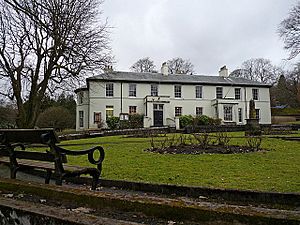Bedwellty House facts for kids
Bedwellty House is a beautiful old house with lovely gardens in Tredegar, a town in south-east Wales. It's a special building, listed as Grade II, which means it's important for its history and looks. The gardens are also very special and are the only ones like them in the Blaenau Gwent area.
Contents
A Look Back at Bedwellty House
How Bedwellty House Began
Long ago, a smaller house called Plas Bedwellty stood here. In 1800, a man named Samuel Homfray, who owned iron factories, bought it. He rebuilt the house in 1825. Later, his son made it even bigger by adding two wings by 1842.
From Private Home to Public Gem
By the mid-1800s, the original owners, the Morgan family, got the house back. They used it for the manager of their big company, the Tredegar Iron and Coal Company. In 1901, the Morgan family generously gave Bedwellty House and its grounds to the local community. It was then used as offices for the local council.
Restoring a Historic Treasure
Many years later, between 2006 and 2011, Bedwellty House and its gardens were carefully restored. This project was supported by the Heritage Lottery Fund and other groups. Today, Bedwellty House is still a Grade II listed building, recognized for its importance.
Exploring the Bedwellty Gardens and Park
Discovering the Victorian Gardens
The house is surrounded by a large, 26-acre Victorian garden and park. It was first designed like a Dutch garden, where you could walk or ride without seeing any fences or outside areas.
Special Features in the Park
Today, visitors can see many interesting things in the park:
- The Long Shelter: This is a special Grade II-listed building that was built for the Chartist movement. The Chartists were a group of people in the 1800s who wanted more rights for ordinary working people.
- An Edwardian bandstand: This is where bands used to play music for people to enjoy.
- A lovely gazebo: A small, open building in the garden, perfect for relaxing.
- Duck ponds: Home to many ducks.
- A famous lump of coal: This is a huge, 15-ton block of coal. Miners from South Wales dug it out for the Great Exhibition in 1851, which was a huge show of inventions and art from around the world.
In 2022, Cadw, the Welsh government's historic environment service, also listed the park as Grade II on its special register of parks and gardens. This means the park is also very important historically.
See also
- List of gardens in Wales


